VOICE OF FLAME
Mando: A Union of Love, Lament, and Resistance | Discover India Program
22 Aug 2024 | Author: Suhani Vora |
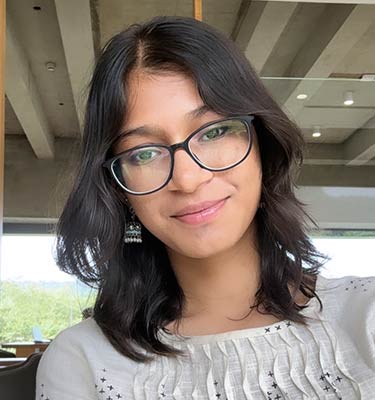
Mando: A Union of Love, Lament, and Resistance | Discover India Program
Vorsam sabar sarlea uprant pordesant
After being long abroad
Vorsam sabar sarlea uprant pordesant,
After spending several years abroad
Goenchi umxik tufan korta kallzant.
The longing for Goa stirs a storm in the heart,
Goenchem char ufo taamchea monant,
The city of Goa hovers in their mind,
Rudoi buddtaukanchea somdirant. (Dukamchea sodirant).
Drowned in the sea of sorrow.
Lyrics: Prof. Levind Rodrigues.
Music: Rev. Dr. Lagran Fernandes
(Songs from Goa, 2024)
While Goa is well-known for its beaches and busy nightlife, the deeper cultural currents that run through the state, shaped by centuries of Portuguese rule, are less well explored. As part of the Discover India Program (DIP), our team sought to dive into the origins, concepts, and present relevance of the Mando, an art form that exemplifies the distinct fusion of Indian and Western elements. Our journey led us past the well-trodden tourist trails and into the heart of Goan culture, where the locals greeted us with warmth and generosity. We chose the overarching themes that distinguish this art form and how it symbolizes the convergence of two cultures due to colonization as our research area. It aimed to emphasize this type of expression, which is unique to a particular community and state.
Exploring the Emergence of the Mando
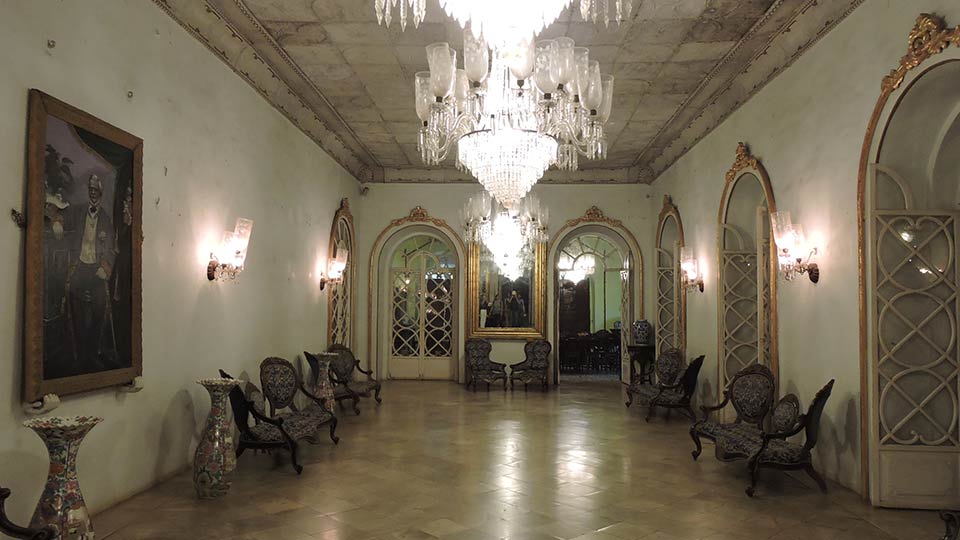
The ballroom present at the Braganza house where Mandos were performed, Chandor. There is a significant intermingling of East and West cultures, which is largely due to the longer period of Portuguese colonial rule in the regions. This protracted period of colonial influence in Goa has resulted in a long-lasting cultural exchange as multiple generations of families grew up under Portuguese influence. The broader socio-cultural phenomenon fundamentally altered the trajectory of Goan cultural evolution and introduced new Creole art forms into the region.
Mando is a music and dance art form; its name is thought to have come from the word "Mand," which means "a stage" or "an arrangement," emphasizing its community aspect. The performance consists of two parts: the slow Mando and the energetic Dulpod, with the latter acting as a postlude. This art form can be presented in two ways: with a transitional verse known as Mando-Dulpod or with a pause between the two. Mando's lyrics, apparel, dancing, and instruments combine subtle Western influences with traditional Indian features in a unique way, demonstrating the convergence of two distinct cultural realms.
Mando: Music, Dance and Lyrics
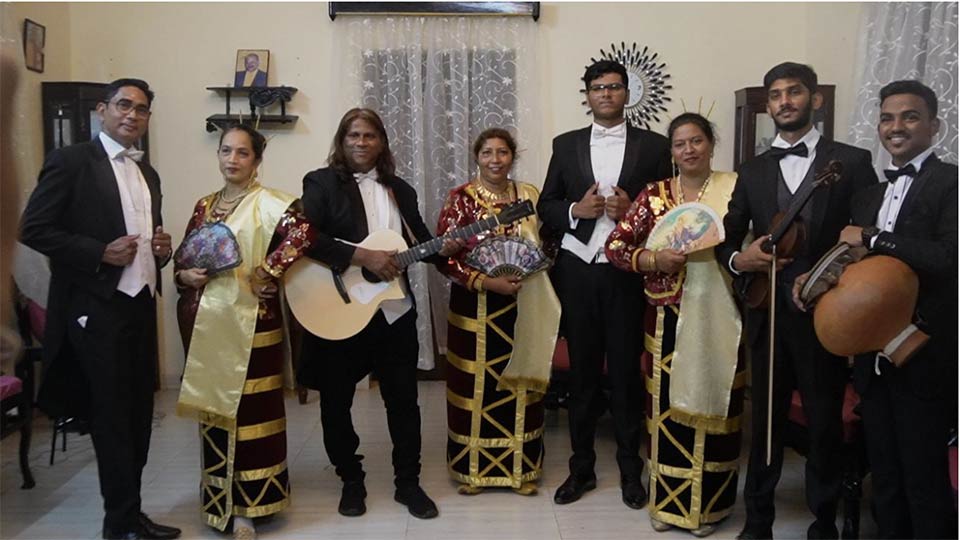
Mando Costumes worn by performers, Quepen While conducting the initial research for our project, we found that there has been minimal research conducted on this art form of Goa. Having been in existence since the 19th century, Mando has been an important part of Goa’s cultural history and its people.
It is primarily performed and composed in Konkani, despite being written in Roman script. In our interview with Franz Schubert Agnelo De Miranda Cotta, a professor of Portuguese studies at Goa University who hails from a family of famous musicians, particularly in the Mando community, says that the Portuguese language is so ingrained in Goan culture that they use it in everyday life. The Mando illustrates the merging of languages.
Costumes play a crucial role in enhancing the impact of the performance. It exemplifies the blending of Goan and Portuguese components in a performance setting. The male performers wear black tailcoats, a white tuxedo shirt, and a bowtie influenced by Western formal clothes. The female performers wear highly embroidered costumes that include a long skirt known as the "Pano-Baju," as well as various ornaments.
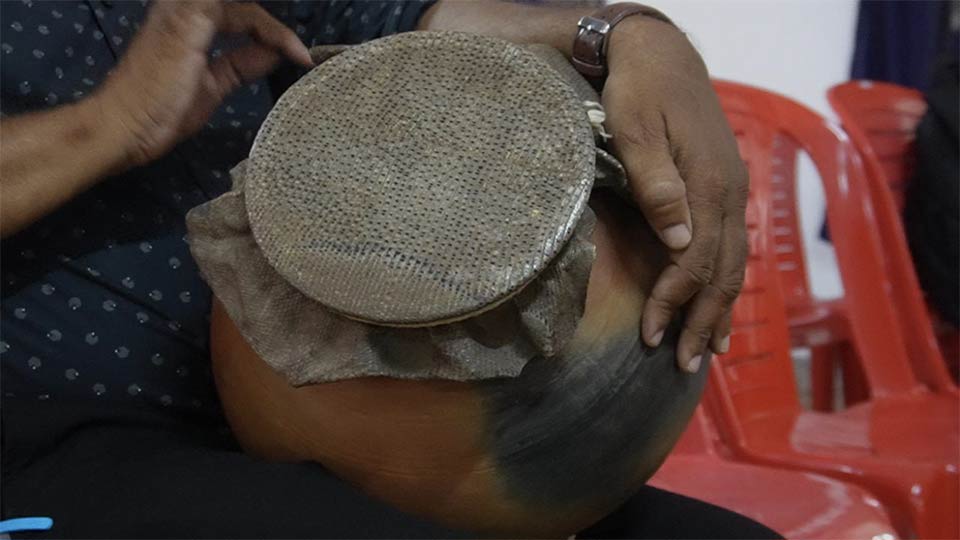
A gumott pot made from the skin of the monitor lizard, Carmel CollegeMando performances are accompanied by traditional Mando instruments such as a gumott and a violin, creating Mando as a bridge between two cultures. The gumott is a membranophone percussion instrument typically built from clay and the hide of the Bengal monitor lizard, which adds a distinct tone to the performance. The use of its skin is prohibited because the species is now protected under the 1972 Wild Life Protection Act, which states that they serve an important role in maintaining ecosystem balance (2024). The monitor lizard skin was later replaced with goat hide to create the gumott.
The Impact of Goan History on the Mando
The Mando isn't merely a performance; it's a living testament to the state's complex history. It can be traced to the 18th century when Portugal ruled Goa for a lengthy period (1510-1961). The Mando's evolution reflects the establishment of a sophisticated social hierarchy during this period, which also impacted Goa's cultural landscape.
Sonia Shirsat, a well-known Mando and Fado singer, whom we interviewed talked about how the Portuguese missionaries introduced Western music. She emphasized how religious schools have introduced Goan youth to Western classical music since the 1500s. However, the Catholic Church, wary of Hindu influences, restricted participation in traditional dance forms. This led to the creation of a new genre – the Mando – that catered to the tastes of the elite Goan Catholic families.
Importance of the Goan Identity
The Mando's evolution is related to Goa's quest for self-determination. Portugal's weakening colonial power, along with Goa's desire for independence, caused social and political upheaval throughout the 18th and 19th centuries. Even after Goa was freed from Portuguese rule in 1961, there was still uncertainty about its future. During this time, the Mando became a potent instrument, its lyrics expressing fears of assimilation and the desire to protect Goa's distinct culture.
An important turning point was the 1967 Goa Opinion Poll, in which most Goans chose to stay as a union territory instead of joining other states. Goa became a state in 1987 as a result of this decision. Goa's distinct status within India was cemented by the adoption of Konkani as the official language and the ongoing appeal of the Mando. The Mando is now a community-wide symbol of Goan identity, transcending its elite beginnings.
Luis, a Mando-Dulpod composer, reminisces about the Mando from his childhood. "When we were kids, our parents used to sing," he says. "They used to sing us some Dulpod lullabies even as they were putting us to sleep." The three main themes of the Mando; love, lament, and resistance, reflect the state of society and politics. This connects the Mando to people's essence, likening it to a clay pot skillfully fashioned by the potter's hands and based on his desire.
MŌG
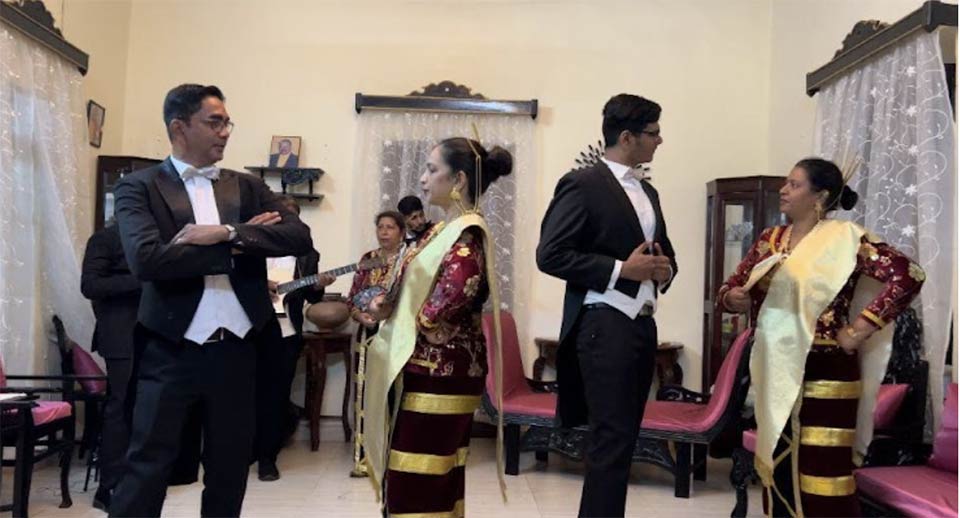
The male dancers are holding intense eye contact while courting the female dancers, Quepen Fundamentally, The Mando is a love song. Many of the individuals we spoke with for our fieldwork echoed this sentiment; Tomazinho Cardozo was just one of many who emphasized the significance and inclusion of love in a sung Mando.
According to our observations, the Mando dance starts slowly before picking up speed as the Dulpod portion of the performance begins. Additionally, we saw that the dancers, as they swayed across the stage, frequently approached but never touched, demonstrating the influence of Indian classical dance forms.
The dance complies with traditional Indian norms, which state that dancers must make intense eye contact with one another in order to communicate feelings other than physical affection while expressing love.
VILLAP
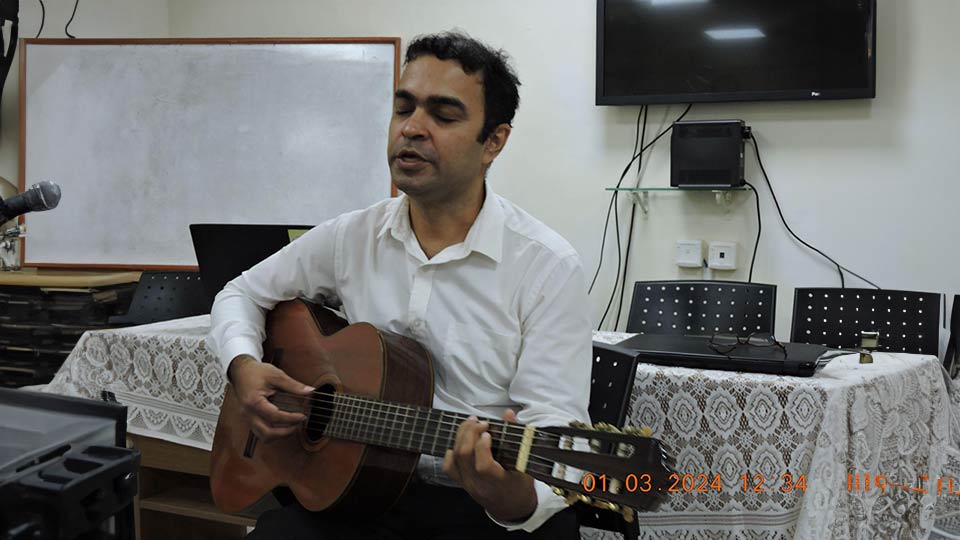
Cotta singing the Mando, Goa University The Mando tradition is rooted in the core of love, yet its composers recognise that love doesn't always result in fulfillment. Villap or separation is a typical occurrence, leaving people to live with the longing for a love that never was. Mando's variety is deepened by this recurrent theme of unfulfilled love, which also greatly resonates with the audience.
People are drawn to the art form because they can identify with the universal emotion of heartbreak and longing that is portrayed in its verses. The Mando is more than just entertainment; it's a tool for negotiating the nuances of interpersonal relationships and group experiences.
We encountered the Mando “Adeus Korcho Vellu Paulo” on several occasions while conducting our fieldwork. It struck a chord with many Goans and aptly embodied the concept of lament. It has additional personal significance for Franz Schubert Agnelo De Miranda Cotta, a professor of Portuguese studies at Goa University, who comes from a lineage of famous musicians, especially in the Mando community. He explained that he doesn't perform this Mando often because it is quite emotional. He talked about how this Mando is emotional which is why he avoids performing it often. However, he kindly performed it for us and that is when we realized that Mando transcends the language barrier. We felt the melancholy and sorrow through the musicality and expressions.
Mando can show how resilient love can be in the face of hardship. They portray the agony of couples ripped apart by the demands of war, together with the steadfast hope that keeps them going even in the most dire circumstances. The narrative is made more complex by the historical background of Portuguese colonization, highlighting the difficulties experienced by people whose lives fall apart by uncontrollable forces.
FOBRO
Mandos' final key theme is "Fobro," or social critique. As was previously established, the art form consists of two parts: the slow, sad love ballad and the fast-paced Dulpod. It is the primary documentation source for the sociopolitical circumstances in Goa that are told through these Dulpods.
One example of the Dulpod tradition that captures its spirit is the piece called "Undir Mojéa Mãmã," which is also known as the "Cat and Mouse" Dulpod. The song is humorous, with the cats standing in for the Goans and the rats for the Portuguese colonialists. It refers to a specific occurrence on September 21, 1890, during the Salcete elections, in Margão's Church Square of the Espírito Santo Church, where soldiers of the Portuguese Governor Vasco Guedes shot an unarmed mob.
A wide range of contemporary issues that the public is confronting are now included in modern Dulpods, which represents the changing nature of Goan society. These modern-day Dulpods offer a venue for critical issues, like regional issues, uneven roads or worldwide environmental concerns like global warming. It is possible that the Dulpods and the Mandos are not always linked. Sometimes they are related, while other times they may be written on quite unrelated topics. The idea of resistance emerged after liberation rather than necessarily coinciding with the beginnings of the art form itself.
Language of the People
Determining the process of creolization that the art form underwent was one of the inquiries we conducted throughout our fieldwork. To comprehend this, it was necessary for us to initially ascertain whether the art form had ever been creolized. We arrived at a paradoxical viewpoint when we recognised that, although the language used to write the Mandos is not creolized, music and dance as art forms may be, as they draw from both Eastern and Western influences.
The Portuguese and Konkani languages used to write the Mando are mixed for a purpose. There are essentially two causes; The first is that as the decades went by, wealthy Catholic families were gradually taught the Portuguese language and way of life. They finally merged some Portuguese words with their Konkani.
Sonia Shirsat offered us another viewpoint to think about, stating that certain Portuguese words work better when attempting to express emotions through a Mando. It's a straightforward rationale that has to do with a more personal mode of communication. Ultimately, it becomes challenging to discern the exact differences between Konkani and Portuguese vocabulary, and the significance of the message is emphasized above the language.
Festivalisation of the Art Form: Authenticity vs Preservation
The Mando art form has seen a decline in popularity. We believe that one of the possible explanations for this is that the Mando originated and was performed by a certain society. It was transmitted from one generation to the next before being widely known to the general public. Therefore, the Mando can be considered a non-traditional folk music that yet has the quality of passing down knowledge from one generation to the next.
These days, younger individuals are more likely to like Dulpods, which stand out for having an upbeat tempo. It's interesting to note that Dulpods have become more well-known than Mandos since they have influenced many cross-cultural Bollywood dance music compositions.
Our study ended with the present discussions concerning its adaptation and preservation through our investigation into the festivalization process. It highlighted the way in which tradition and creativity interact within the framework of the Mando art form. "Festivalization" is the term used to describe how regular cultural activities are changed into new events. On the other hand, everyone views this process differently. It has been stated that adding new elements to an existing art form dilutes it. The youth wants to "add their twists" to Mando. In the same way, another person expressed the opinion that the Mando does not need to change because it will lose its effectiveness if it is diluted.
The discussion of the Mando tradition includes not only the opinions of academics and cultural analysts, but also the views of practitioners and members of the community. These stakeholders have a significant impact on how cultural practices and traditions develop. The enjoyment, disasters, triumphs, and hardships of Goan existence are fundamentally captured in the Mando tradition. Mandos, whether they are performed at small get-togethers or large celebrations, encourage a sense of unity and kinship among attendees.
The Discover India Program has been an extraordinary journey that transcended the boundaries of a typical academic endeavor. We were welcomed with open arms by people who were eager to share their experiences with us. Their stories and traditions offered us a glimpse into what lies within the heart of our country. The challenges we faced and the connections we forged have broadened our perspectives and deepened our appreciation for our shared heritage.
Goans have something valuable to future generations by keeping the Mando tradition alive. In a world that is constantly changing, Goans make sure that their cultural legacy endures and is vibrant by continuing to cherish and celebrate the Mandos.
Team Members:
Aanya Tanwar, Aarushi Sharma, Anusha Bapat, Ishita Tripathi, Kahan Dave, Krati Gupta, Pranay Krishna, Sharayu Pednekar, Suhani Vora , Tanvi Bhandary, Veda Jain, Vihaan Suneja, Vrinda Tuteja
(Author: Suhani Vora, Undergraduate Student)






